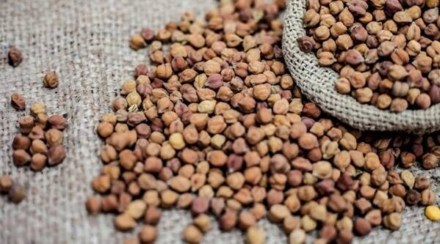Saddled with 1.9 million tonne (MT) of buffer stocks of chana or gram less than two months ahead of harvest season, the government is considering a proposal to further reduce the prices of the pulses variety being offered to states for distribution in the social sector schemes.
Currently, out of 1.5 MT of chana offered to states at discounted price of `8 per kg for distribution through the social sector programme, only 0.4 MT has been lifted by states, including Gujarat, Madhya Pradesh, Kerala, Andhra Pradesh and Tamil Nadu.
“We are considering a proposal to further reduce prices of chana offered to states to decrease buffer stocks as procurement of the new season will be commencing by April,” an official told FE. He said the government is aiming to reduce old chana stock to create space for new arrivals.
In August last year, the Cabinet had approved the disposal of 1.5 MT of chana from the surplus buffer stock held with the farmers’ cooperative Nafed to states. This was for supplying through various social sector schemes — public distribution system, mid-day meal schemes etc.
The states and Union territories have given a timeframe of one year or till disposal of 1.5 MT of chana for availing benefits of the scheme.
The government is expected to incur an expense of Rs 1,200 crore for the implementation of the scheme. The key purpose of the scheme was to create space for warehouses required for the procurement of gram from April 2023 onward.
At the beginning of February, 2023, against the government’s buffer stock norm of 2.3 MT, Nafed had close to 2.7 MT of pulses. Of this, the chana stock is more than 1.9 MT. A portion of the stock is close to two years old.
However, in the case of other varieties of pulses, because of lower procurement, the government’s stocks are smaller — moong (0.6 MT), urad (0.07 MT) and tur (0.05 MT) at present.
Due to a record chana production of 13.75 MT in the 2021-22 crop year (July-June), Nafed procured more than 2.5 MT of pulses in the 2022-23 (April-June) season under the price support scheme, aimed at providing minimum support price (MSP) to farmers.
The pulses variety has a share of close to 50% in the country’s production of 27.69 MT in the 2021-22 crop year (July-June).
Stating that Nafed often offloads in the market at discounted prices and this leads to sharp decline in market prices of the commodity, the Commission for Agricultural Costs and Prices (CACP), in its report of price policy for rabi crops for the marketing season 2022-23, has stated it was highly desirable to fix a reserve price that is linked to MSP, for disposal of stocks similar to wheat and rice, under the Open Market Sale Scheme being implemented by the Food Corporation of India.
